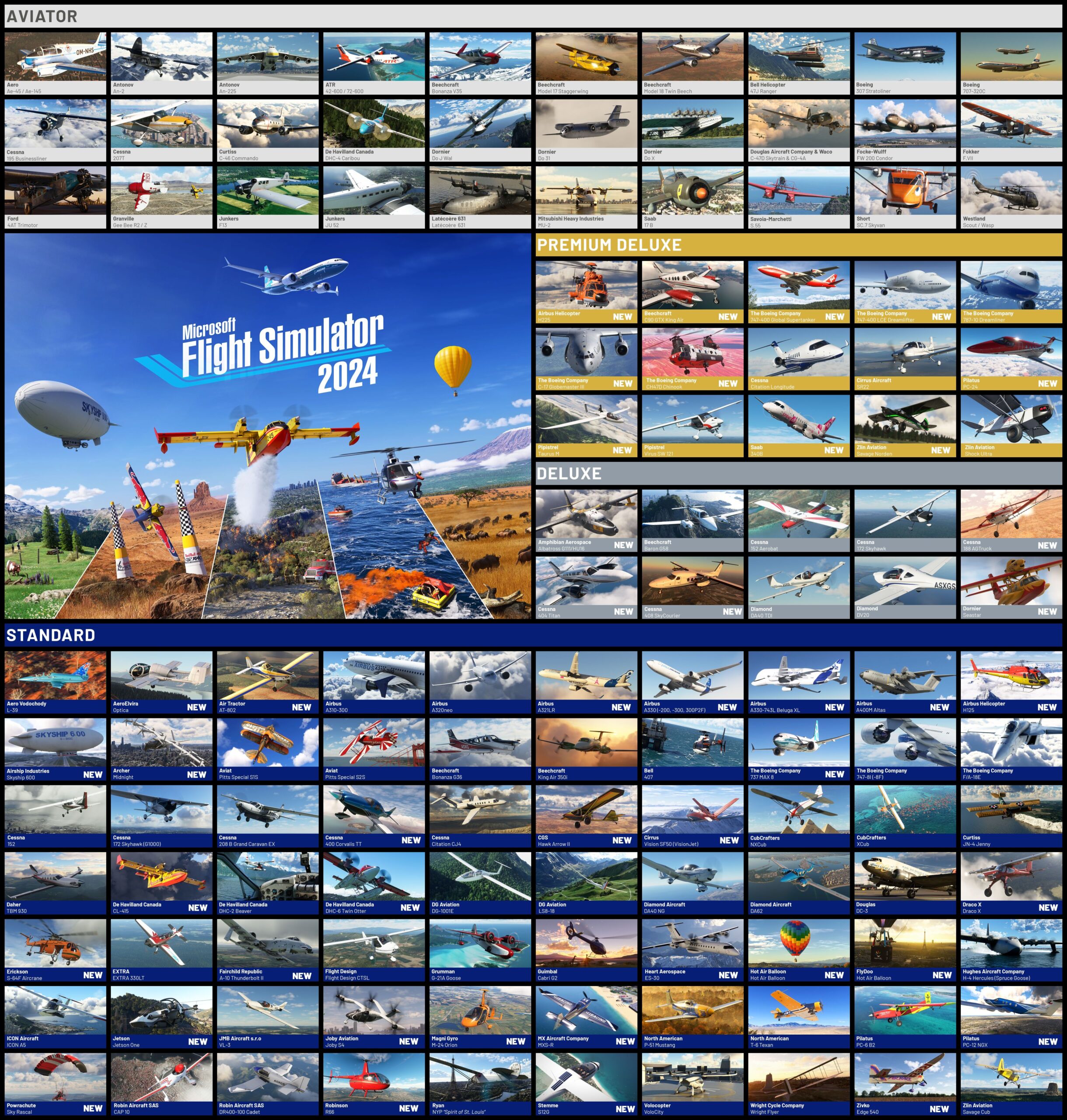news.xbox.com
Microsoft Flight Simulator 2024 is by far our most ambitious simulator to date, and we are incredibly excited for all of you from our core sim fans to all gamers and those who want to explore the world with us to join us on this journey. With authentic realism of all environments, aviation careers to pursue and the ability to explore our beautiful world with various kinds of aircraft, there is something amazing for everyone in this version of the simulator.We feel very fortunate that Microsoft Flight Simulator has a vibrant, highly informed and passionate community which has been invaluable on our journey to continually improve the simulator. Our motto is for the community with the community, which means that we will continue to carefully listen to your feedback and suggestions to help guide our development efforts and it also means that we will continue to work with teams from the community to help us produce the best aircraft, airports, scenery, missions, and other features.The team at Asobo is very much the core with the engine and key innovations all coming from the team in Bordeaux. We were able to substantially enhance the breadth and quality by inviting other creator teams from the flight sim community to help and bring focus to the many areas of this vast simulator. Aircraft were built by well-known and loved community teams like iniBuilds, Carenado, Got Friends, Blackbird, Hype Performance Group, MilTech, S&H, FlightFX, DC Designs, ATSimulations, BlueMesh and others to create the largest and most detailed fleet we have ever had (70 aircraft) for the base simulator. Other areas like airports, heliports, glider airports were mostly built by the talented team at Gaya, worldwide obstacles by Orbx & Puffin Flight, animals by Lakshya and via a collaboration with Frontier Developments, air racing by Climax, and many other elements like avionics and flight planning from Working Title. In total, we had over 800 people contributing to the sim and the result is beautiful and incredibly impressive.The dream of flight is ingrained in us yet many people have been unable to pursue that dream due to a lack of opportunity to pilot their own plane MSFS 2024 provides 70 highly diverse aircraft, our entire beautiful Earth, and many activities to suit your aviation desires.Thank you for embarking on this incredible adventure with us. We hope you enjoy Microsoft Flight Simulator 2024.The Sky Is Calling.Microsoft Flight Simulator 2024 is now available in a variety of editions. The Standard Edition available with Game Pass Ultimate and PC Game Pass comes with 70 aircraft and 150 upgraded airports; Deluxe Edition includes 10 additional aircraft and five extra airports; the Premium Deluxe includes another 15 aircraft (total of 95); Aviator Edition includes everything from the Premium Deluxe Edition plus the entire fleet of 30 Microsoft-published Marketplace aircraft developed for Microsoft Flight Simulator between 2021 and 2024. If you own Microsoft Flight Simulator (2020) Deluxe Edition or Premium Deluxe Edition the additional aircraft and airports unique to these editions will automatically work in Microsoft Flight Simulator 2024.Microsoft Flight Simulator 2024 Standard EditionXbox Game Studios99$69.99Get it nowStandard EditionExplore the world with our largest fleet of aircraft and take simulation to new heights while pursuing your aviation career within Microsoft Flight Simulator 2024. The Standard Edition includes over 65 aircraft and 150 handcrafted airports.Fly with Purpose Launch your aviation Career wherever you choose in the world. Gain experience, build your reputation, and complete certifications to gain access to authentic aviation activities ranging from Medevac, Remote Cargo Ops, Aerial Firefighting, Search & Rescue and more, all the way to becoming an Airline Passenger Transport Pilot. Set out on a truly global aviation adventure with virtually unlimited missions across the planet. Compete against other pilots in the all-new Challenge League mode or hone your skills in dozens of Activities ranging from exciting Rally Races and Precision Landings to Low-Altitude challenges and more. Fly head-to-head in the iconic Red Bull Air Races and the legendary Reno Air Races, including the new Roswell courses. Be a World Photographer and travel across our beautiful planet to capture awe-inspiring natural vistas, visit famous landmarks, and record these adventures with pictures in your travel book. Unique photo challenges test your creative eye along with your piloting skills while you strive to capture the perfect moment.Advanced Simulation Enhanced physics system allows 10,000+ rigid-body surfaces that enable the simulation of any shape of aircraft. Soft body physics supports cloth, ropes, balloons, and more. Improved ground and water handling further enhance realism. New, highly accurate aircraft systems including electrical, pneumatic, fuel and hydraulic systems, payload and passenger systems, and avionics like the Universal UNS-1 FMS and Honeywell Primus Epic 2. Preflight inspections and walkaround checks add to immersion. Plan your flights with a groundbreaking flight planner which supports both IFR and VFR map layers, IFR charts, route planning, fuel and payload planning, vertical profile planning, and ETOPS planning. It also provides airport information including weather and NOTAMS and is available native in the sim, on mobile devices or web browsers for flight planning outside the simulator.Explore Our Visually Stunning Digital Twin Explore our most detailed re-creation of planet Earth to date. Enhanced digital elevation maps, over 500 TIN (triangular irregular network) cities and more than 100,000 square kilometers of countryside photogrammetry allow for visually stunning digital twin experiences. More than 150 airports, 2,000 glider airports, 10,000 heliports, 2,000 points of interest, and 900 oil rigs have been carefully hand-crafted while a procedural system generates all 40,000 airports, 80,000 helipads, 1.5 billion buildings, and nearly 3 trillion trees our planet. Land anywhere and, for the first time in Microsoft Flight Simulator, exit your aircraft to explore 27 highly detailed biomes with hundreds of species of vegetation, dynamically created details including grass, rocks, and flowers all influenced by seasonal changes.The all-new photometric lighting system renders the world more accurately than ever before, and enhanced weather features such as new cloud types, auroras, and other weather phenomena produce fresh and compelling atmospheric experiences. The world comes alive with a vast array of land-based wildlife in their natural habitats and free-ranging livestock across the entire globe. The oceans and waterways are teeming with live, worldwide maritime traffic ranging from large tankers and cargo ships to trawlers, tugs, and more. A richly diverse, regionally accurate representation of humanity brings life to the airports, aircraft, and passenger cabins of the world. Enhanced real-world air traffic populates the skies and airport tarmacs with hundreds of accurately depicted aircraft models and dozens of officially licensed liveries.Microsoft Flight Simulator 2024 Deluxe EditionXbox Game Studios156$99.99Get it nowDeluxe EditionExplore the world with our largest fleet of aircraft and take simulation to new heights while pursuing your aviation career within Microsoft Flight Simulator 2024. The Deluxe Edition includes everything from the Standard Edition plus 10 additional aircraft and 5 additional handcrafted international airports.Fly with Purpose Launch your aviation Career wherever you choose in the world. Gain experience, build your reputation, and complete certifications to gain access to authentic aviation activities ranging from Medevac, Remote Cargo Ops, Aerial Firefighting, Search & Rescue and more, all the way to becoming an Airline Passenger Transport Pilot. Set out on a truly global aviation adventure with virtually unlimited missions across the planet. Compete against other pilots in the all-new Challenge League mode or hone your skills in dozens of Activities ranging from exciting Rally Races and Precision Landings to Low-Altitude challenges and more. Fly head-to-head in the iconic Red Bull Air Races and the legendary Reno Air Races, including the new Roswell courses. Be a World Photographer and travel across our beautiful planet to capture awe-inspiring natural vistas, visit famous landmarks, and record these adventures with pictures in your travel book. Unique photo challenges test your creative eye along with your piloting skills while you strive to capture the perfect moment.Advanced Simulation Enhanced physics system allows 10,000+ rigid-body surfaces that enable the simulation of any shape of aircraft. Soft body physics supports cloth, ropes, balloons, and more. Improved ground and water handling further enhance realism. New, highly accurate aircraft systems including electrical, pneumatic, fuel and hydraulic systems, payload and passenger systems, and avionics like the Universal UNS-1 FMS and Honeywell Primus Epic 2. Preflight inspections and walkaround checks add to immersion. Plan your flights with a groundbreaking flight planner which supports both IFR and VFR map layers, IFR charts, route planning, fuel and payload planning, vertical profile planning, and ETOPS planning. It also provides airport information including weather and NOTAMS and is available native in the sim, on mobile devices or web browsers for flight planning outside the simulator.Explore Our Visually Stunning Digital Twin Explore our most detailed re-creation of planet Earth to date. Enhanced digital elevation maps, over 500 TIN (triangular irregular network) cities and more than 100,000 square kilometers of countryside photogrammetry allow for visually stunning digital twin experiences. More than 150 airports, 2,000 glider airports, 10,000 heliports, 2,000 points of interest, and 900 oil rigs have been carefully hand-crafted while a procedural system generates all 40,000 airports, 80,000 helipads, 1.5 billion buildings, and nearly 3 trillion trees our planet. Land anywhere and, for the first time in Microsoft Flight Simulator, exit your aircraft to explore 27 highly detailed biomes with hundreds of species of vegetation, dynamically created details including grass, rocks, and flowers all influenced by seasonal changes.The all-new photometric lighting system renders the world more accurately than ever before, and enhanced weather features such as new cloud types, auroras, and other weather phenomena produce fresh and compelling atmospheric experiences. The world comes alive with a vast array of land-based wildlife in their natural habitats and free-ranging livestock across the entire globe. The oceans and waterways are teeming with live, worldwide maritime traffic ranging from large tankers and cargo ships to trawlers, tugs, and more. A richly diverse, regionally accurate representation of humanity brings life to the airports, aircraft, and passenger cabins of the world. Enhanced real-world air traffic populates the skies and airport tarmacs with hundreds of accurately depicted aircraft models and dozens of officially licensed liveries.Microsoft Flight Simulator 2024 Premium Deluxe EditionXbox Game Studios155$129.99Get it nowPremium Deluxe EditionExplore the world with our largest fleet of aircraft and take simulation to new heights while pursuing your aviation career within Microsoft Flight Simulator 2024. The Premium Deluxe Edition includes everything from the Standard Edition plus 25 additional aircraft and 10 additional handcrafted international airports.Fly with Purpose Launch your aviation Career wherever you choose in the world. Gain experience, build your reputation, and complete certifications to gain access to authentic aviation activities ranging from Medevac, Remote Cargo Ops, Aerial Firefighting, Search & Rescue and more, all the way to becoming an Airline Passenger Transport Pilot. Set out on a truly global aviation adventure with virtually unlimited missions across the planet. Compete against other pilots in the all-new Challenge League mode or hone your skills in dozens of Activities ranging from exciting Rally Races and Precision Landings to Low-Altitude challenges and more. Fly head-to-head in the iconic Red Bull Air Races and the legendary Reno Air Races, including the new Roswell courses. Be a World Photographer and travel across our beautiful planet to capture awe-inspiring natural vistas, visit famous landmarks, and record these adventures with pictures in your travel book. Unique photo challenges test your creative eye along with your piloting skills while you strive to capture the perfect moment.Advanced Simulation Enhanced physics system allows 10,000+ rigid-body surfaces that enable the simulation of any shape of aircraft. Soft body physics supports cloth, ropes, balloons, and more. Improved ground and water handling further enhance realism. New, highly accurate aircraft systems including electrical, pneumatic, fuel and hydraulic systems, payload and passenger systems, and avionics like the Universal UNS-1 FMS and Honeywell Primus Epic 2. Preflight inspections and walkaround checks add to immersion. Plan your flights with a groundbreaking flight planner which supports both IFR and VFR map layers, IFR charts, route planning, fuel and payload planning, vertical profile planning, and ETOPS planning. It also provides airport information including weather and NOTAMS and is available native in the sim, on mobile devices or web browsers for flight planning outside the simulator.Explore Our Visually Stunning Digital Twin Explore our most detailed re-creation of planet Earth to date. Enhanced digital elevation maps, over 500 TIN (triangular irregular network) cities and more than 100,000 square kilometers of countryside photogrammetry allow for visually stunning digital twin experiences. More than 150 airports, 2,000 glider airports, 10,000 heliports, 2,000 points of interest, and 900 oil rigs have been carefully hand-crafted while a procedural system generates all 40,000 airports, 80,000 helipads, 1.5 billion buildings, and nearly 3 trillion trees our planet. Land anywhere and, for the first time in Microsoft Flight Simulator, exit your aircraft to explore 27 highly detailed biomes with hundreds of species of vegetation, dynamically created details including grass, rocks, and flowers all influenced by seasonal changes.The all-new photometric lighting system renders the world more accurately than ever before, and enhanced weather features such as new cloud types, auroras, and other weather phenomena produce fresh and compelling atmospheric experiences. The world comes alive with a vast array of land-based wildlife in their natural habitats and free-ranging livestock across the entire globe. The oceans and waterways are teeming with live, worldwide maritime traffic ranging from large tankers and cargo ships to trawlers, tugs, and more. A richly diverse, regionally accurate representation of humanity brings life to the airports, aircraft, and passenger cabins of the world. Enhanced real-world air traffic populates the skies and airport tarmacs with hundreds of accurately depicted aircraft models and dozens of officially licensed liveries.Microsoft Flight Simulator 2024 Aviator EditionXbox Game Studios151$199.99Get it nowAviator EditionExplore the world with our largest fleet of aircraft and take simulation to new heights while pursuing your aviation career within Microsoft Flight Simulator 2024. The Aviator Edition includes everything from the Premium Deluxe Edition plus the entire fleet of 30 Microsoft-published Marketplace aircraft developed for Microsoft Flight Simulator between 2021 and 2024.Fly with Purpose Launch your aviation Career wherever you choose in the world. Gain experience, build your reputation, and complete certifications to gain access to authentic aviation activities ranging from Medevac, Remote Cargo Ops, Aerial Firefighting, Search & Rescue and more, all the way to becoming an Airline Passenger Transport Pilot. Set out on a truly global aviation adventure with virtually unlimited missions across the planet. Compete against other pilots in the all-new Challenge League mode or hone your skills in dozens of Activities ranging from exciting Rally Races and Precision Landings to Low-Altitude challenges and more. Fly head-to-head in the iconic Red Bull Air Races and the legendary Reno Air Races, including the new Roswell courses. Be a World Photographer and travel across our beautiful planet to capture awe-inspiring natural vistas, visit famous landmarks, and record these adventures with pictures in your travel book. Unique photo challenges test your creative eye along with your piloting skills while you strive to capture the perfect moment.Advanced Simulation Enhanced physics system allows 10,000+ rigid-body surfaces that enable the simulation of any shape of aircraft. Soft body physics supports cloth, ropes, balloons, and more. Improved ground and water handling further enhance realism. New, highly accurate aircraft systems including electrical, pneumatic, fuel and hydraulic systems, payload and passenger systems, and avionics like the Universal UNS-1 FMS and Honeywell Primus Epic 2. Preflight inspections and walkaround checks add to immersion. Plan your flights with a groundbreaking flight planner which supports both IFR and VFR map layers, IFR charts, route planning, fuel and payload planning, vertical profile planning, and ETOPS planning. It also provides airport information including weather and NOTAMS and is available native in the sim, on mobile devices or web browsers for flight planning outside the simulator.Explore Our Visually Stunning Digital Twin Explore our most detailed re-creation of planet Earth to date. Enhanced digital elevation maps, over 500 TIN (triangular irregular network) cities and more than 100,000 square kilometers of countryside photogrammetry allow for visually stunning digital twin experiences. More than 150 airports, 2,000 glider airports, 10,000 heliports, 2,000 points of interest, and 900 oil rigs have been carefully hand-crafted while a procedural system generates all 40,000 airports, 80,000 helipads, 1.5 billion buildings, and nearly 3 trillion trees our planet. Land anywhere and, for the first time in Microsoft Flight Simulator, exit your aircraft to explore 27 highly detailed biomes with hundreds of species of vegetation, dynamically created details including grass, rocks, and flowers all influenced by seasonal changes.The all-new photometric lighting system renders the world more accurately than ever before, and enhanced weather features such as new cloud types, auroras, and other weather phenomena produce fresh and compelling atmospheric experiences. The world comes alive with a vast array of land-based wildlife in their natural habitats and free-ranging livestock across the entire globe. The oceans and waterways are teeming with live, worldwide maritime traffic ranging from large tankers and cargo ships to trawlers, tugs, and more. A richly diverse, regionally accurate representation of humanity brings life to the airports, aircraft, and passenger cabins of the world. Enhanced real-world air traffic populates the skies and airport tarmacs with hundreds of accurately depicted aircraft models and dozens of officially licensed liveries.











